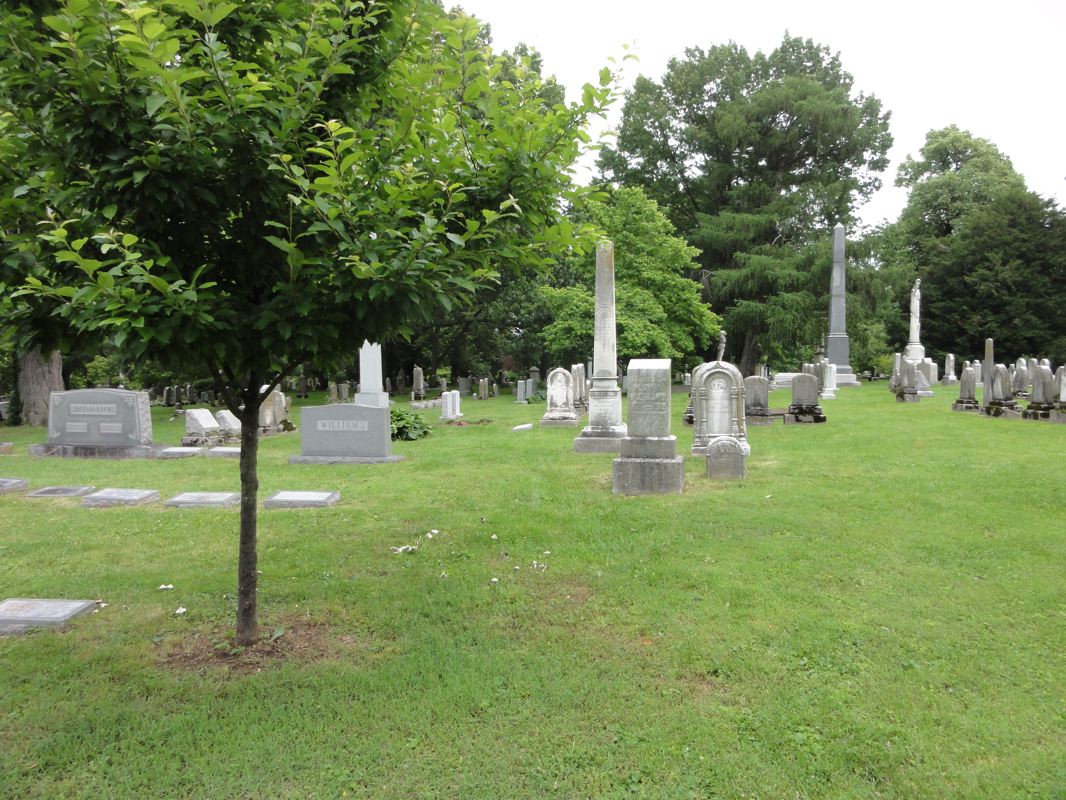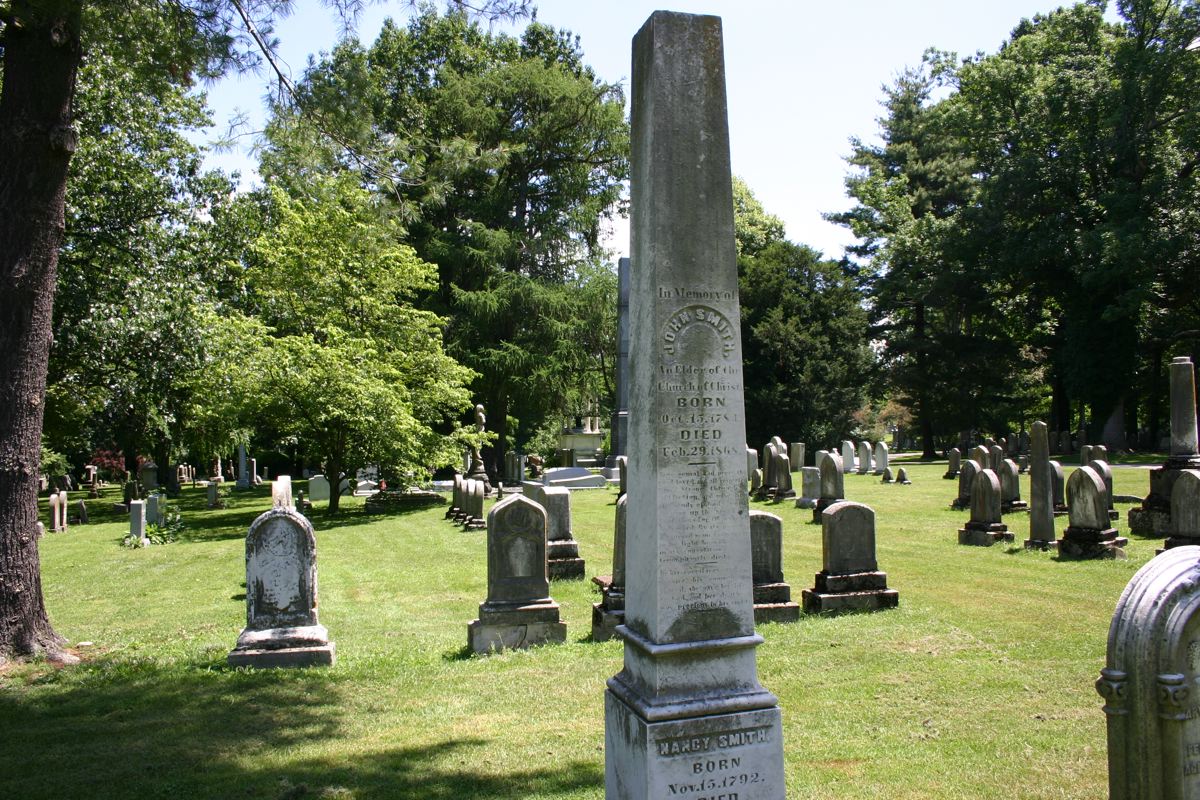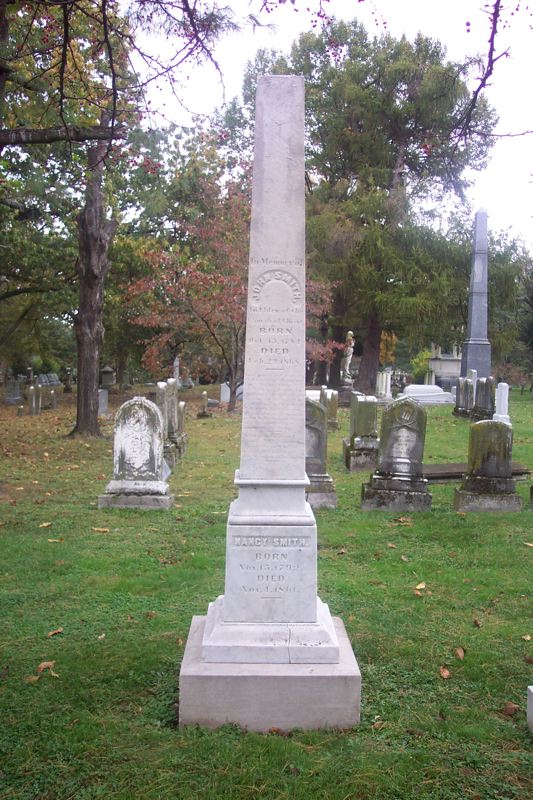"Raccoon" John Smith
1784-1868
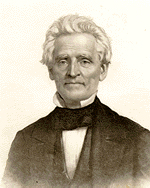
John Smith was born on October 15, 1784 in East Tennessee, in what is now known as Sullivan County. He has been called the Peter Cartwright and Lorenzo Dow of the Restoration Movement. He was truly a unique character, a product of the age in which he lived. Alexander Campbell is quoted as saying: "John Smith is the only man that I ever knew who would have been spoiled by a college education." He meant that the unique character would have been so greatly modified by an education that he could not have done the work that he did.
John Smith had very little schooling. He attended school four months in a log schoolhouse when he was but a lad. A little later he enrolled as a student in a private school. This school was so crude that it accomplished very little. The teacher was a drunkard and gave but little attention to his duties as a teacher. It is said that young Smith, to express his contempt for such a teacher, poured a shovel full of hot embers in the teacher's pocket while he sat before his pupils in a drunken stupor. This broke up the school, and Smith never enrolled any more as a student. These few months' schooling quickened his thirst for knowledge, though they furnished him but little opportunity for the acquisition of knowledge.
His parents were Calvinistic Baptists in faith and were rigid in their enforcement of their peculiar theories upon their children. As young Smith verged into manhood he became interested in the subject of religion. He sought the Lord after the custom of the Calvinistic theory. He anxiously waited for the Lord to call him; he truly expected him to call him as one of the elect. He freely and unconsciously imbibed the teaching of his father's creed. All the stories of conversion at that time were full of marvelous incident and spiritual adventure. John Smith listened to the narration of these stories and prayed that they might be made his own experience. His father died about this time, leaving John Smith to take charge of the family affairs. The death of his father and the responsibilities that now fell upon him caused him to more earnestly seek salvation. He tried in vain, it seemed to him, to "get religion." He next turned to reading the Bible, thinking that he might get some comfort from his distressed condition. I've had strong convictions that he was a sinner, and his struggles were painful indeed. Finally he was told that he had been "converted." He rejoiced to hear this and believed it; however, he had not had the marvelous experiences that commonly attended conversions of that kind. There was an element of doubt in his own mind. He was assured that this doubt was one of the tokens of God's mercy to him. He submitted his case to the Baptist Church, and the church unanimously passed on his conversion and he was immediately taken into the fold of the Baptist Church.
Soon after he became a member of the Baptist Church he had a strong desire to be a preacher. He worried no little about "a call to preach." He could not understand why he should have such a strong desire to preach and yet the Lord would not call him. He began to talk at prayer meeting, and the more he participated in the prayer-meeting work, the stronger grew his desire to preach. He continued talking at prayer meeting and at the houses of his neighbors. He was reprimanded for preaching "without a call." Finally he persuaded himself that he had received the "call to preach." He lost no time in getting into the work of a Baptist preacher.
He began reading the New Testament and pondering over the word of the Lord. He memorized much of the Scripture, which was a strange thing in that day. He read and studied the New Testament until, when he would arise to preach, he quoted freely from it. Some of his Baptist brethren who were preachers again reprimanded him for preaching so much of the Bible. It was a rare thing for preachers then to quote any of the Bible. The reprimand of his brethren distressed him, and he tried earnestly to satisfy his mind on the proposition. He presented the matter seriously to them in the following way: "Brethren, what shall I do? I must preach; I cannot preach if I do not study the New Testament." He was told that the Lord would give to him what he should say.
About this time he began reading the Christian Baptist, published by Alexander Campbell. From this he learned much and was led into a fuller appreciation of the New Testament teaching. Some time after this Alexander Campbell made a visit to Kentucky, where Smith was living. There was much discussion among the Kentucky Baptists as to whether Mr. Campbell knew anything about "experimental religion," or "heart felt religion." All agreed that Mr. Campbell was a learned man, but many doubted whether he was one of the "elect." So when Mr. Campbell came into Kentucky he was received with some hesitancy on the part of the Baptists. John Smith said that he could tell just what Mr. Campbell was if he could hear him once. He did hear Mr. Campbell. He sat and listened for two hours and thirty minutes, and the time seemed to him only thirty minutes. Some one asked Smith afterwards what he thought of Mr. Campbell if he was one of the elect or not. Smith replied: "I know nothing about the man; but, 'be he saint or devil, he has thrown more light on the Galatian letter and on the whole Scriptures than I have received in all the sermons that I have ever heard before." Through the help he received from Mr. Campbell and an earnest, prayerful rereading of the New Testament Scriptures, Smith saw that the Baptist Church was not the church of his Lord and that the theories which were preached by Baptists were not the gospel of the Lord Jesus Christ. He at once renounced the Baptist faith and embraced the faith of the gospel. It was a hard task to turn away from the religion of his mother and the fellowship and friendship of the Baptist brotherhood. it was quite a task to turn away from such a large and popular brotherhood as was the Baptist Church in Kentucky at that time and become identified with a despised and weak religious body, as were the true disciples at that time. However, he did not hesitate to make the sacrifice. He did it with joy in the newfound truth of the gospel.
He now devoted himself faithfully to the preaching of the gospel. He labored hard to get others to accept the truth, and his labors were not in vain. He was able to get entire congregations of the Baptist faith to turn away from their creed and theories and accept the Bible and work and worship as it directed. He was happy in this great work. He could preach the gospel with convincing power in a unique way. Few could withstand or resist the truth as presented by him. His unique way of handling a subject reached the hearts of the people of the rural sections of the country where he lived. He did a work among them that no other man could do. This he did without the promise or hope of any earthly reward or financial aid. He thus labored for the love of the truth and the salvation of souls. Perhaps John Smith is remembered more for his witticism and repartee than anything else. Many amusing incidents are related about his work. At one time he was preaching on the gospel and contrasting the different theories in religion with the gospel. He said that the gospel had this mark which was peculiar to it: "Whosoever does not believe it shall be damned." This could not be said of any of the theories of man. He put the different theories to the test, and showed that even those who believed in these theories did not claim that those who did not believe them would be "damned." At another time, after he had shown the absurdities of the mourner's bench theory of getting religion, he was asked: "What is the difference between your baptism and our mourner's bench?" He replied: "One is from heaven, the other is from the sawmill." He preached at Sparta, Tennessee, before a number of lawyers and judges. Afterwards he was asked if he was not very much embarrassed in the presence of such learned men. He replied: "Not in the least; for I have learned that judges and lawyers, so far as the Bible is concerned, are the most ignorant class of people in the world, except Doctors of Divinity." Again he said that he had spoken in the presence of all the great preachers of Kentucky, but, "I confess that the first time I ever preached before Alexander Campbell I did falter a little."
John Smith died on February 28, 1868, and was buried in Lexington, Kentucky, He died in the triumphs of the faith of the gospel. His sacrifice and service in the cause of Christ made him a hero in the service of God. Every young preacher can gain much information and inspiration from a study of the life of "Raccoon" John Smith.
-FrommBiographical Sketches Of Gospel Preachers, H. Leo Boles, Gospel Advocate Company, Nashville, Tennessee, 1932, pages 37-41
See Smith's Horse Hollow Cabin Here
![]()
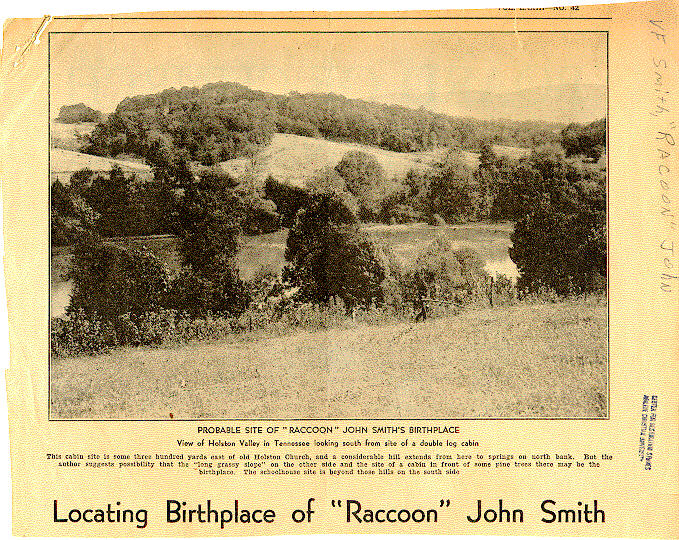
Probable Site of John Smith's Birthplace
Holston Valley In East Tennessee
![]()
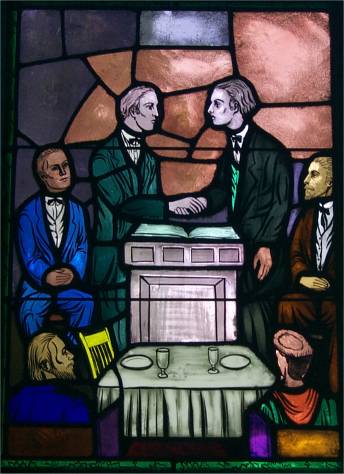
Stained Glass At Cane Ridge,
Designating 1832 Union Of Christians & Disciples
B.W. Stone On Left & John Smith On Right
Photo Taken By Scott Harp In 2000
![]()
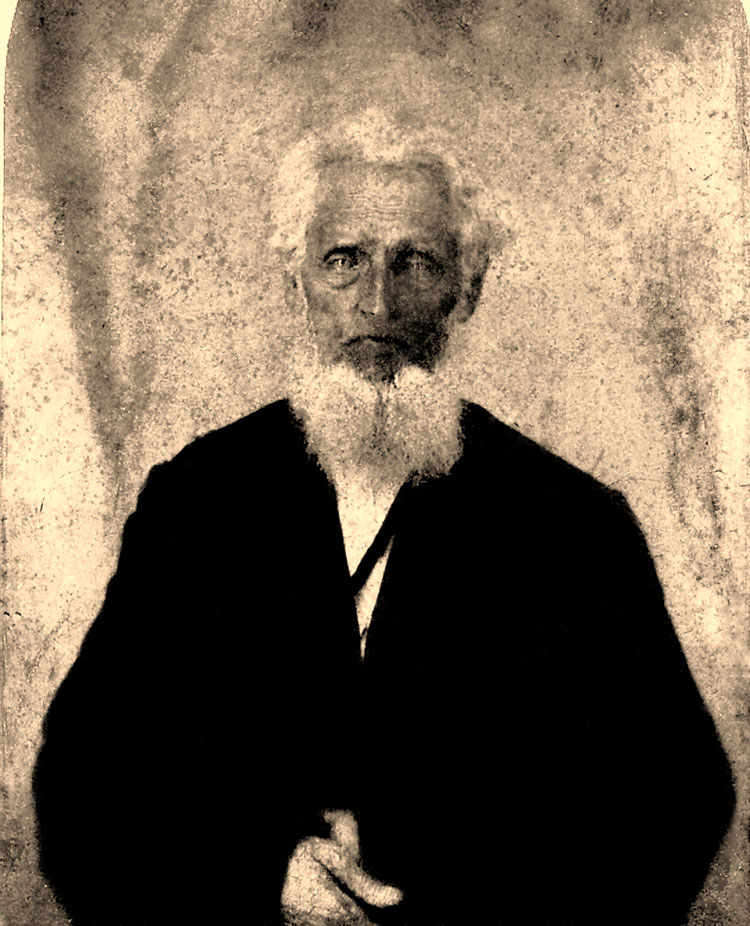
A Late Picture of Raccoon John Smith, Newly Discovered
Contributed by Lloyd Pelfrey, 6.2009
![]()
John Smith, though not greatly educated was one of the most successful and beloved preachers of his day. It was Alexander Campbell, a dear friend to Smith, who once said that John was the only preacher that he had ever known that an education would hurt rather than help.
Smith was greatly involved in the New Year's Day, 1832 union of the Disciples and Christians in Lexington, Kentucky. He preached the first unity sermon. In it he said, "let us, then my brethren, be no longer Campbellites or Stoneites, New Lights or Old Lights, or any other kind of lights, but let us come to the Bible, and to the Bible alone, as the only book in the world that can give us all the light we need." With this mentality, representing Campbell and the Disciples,he shook the hand of Barton W. Stone, the representative of the Christians. The result was unity among churches of Christ. Smith traveled with John Rogers to tell the brotherhood of the joining of two great forces, and to continue preaching New Testament Christianity to the lost and dying world of their day. He baptized thousands into Christ. Only eternity will know of the great accomplished by this great ole' backwoods Tennessee preacher.
![]()
Audio Lectures
Click On Icon Above To Download Your
Free Copy of Real player
Life of "Raccoon" John Smith by Everett Donaldson Lectures On The Life Of "Raccoon" John Smith)
![]()
Chronology Of The Life Of Raccoon John Smith
1732
George Schmidt born in Germany (father of John Smith)
1735
George Smith Landed on Virginia shore settling near the headwaters of the James River.
1766
At 31, GS Marries Rebecca Bowen, an Irish maiden, (Williams, p.11)
1775
George, enlists as a minuteman in the Virginia Militia
1781
October 19
Revolutionary War ended with surrender of Cornwallis at Yorktown, Virginia
1784
Early in year George, Rebecca & 8 children move to Holston River Valley, East Tennessee
October 15
Birth of John, Sullivan County, E. Tennessee, 9th of 13 Children, on Banks of Holston River. (Williams, p.13)
1789
Failed attempt to unite Elkhorn Baptist Association's hardline Calvinists known as Regular Baptists with more relaxed South Kentucky Association group known as Separate Baptists, again attempted in 1793. (Williams, p.124)
1792
Kentucky received Statehood
Failed attempt to unite Elkhorn Baptist Association's hardline Calvinists known as Regular Baptists with more relaxed South Kentucky Association group known as Separate Baptists, earlier attempted in 1789. (Williams, p.124)
1793
Mt. Sterling, "Baptist Church of Jesus Christ" planted within one year of the town being officially recognized by state legislature. (LRJS, p.25) -
1795
Autumn
(Age 11), move to Crab Orchard, Stockton Valley, Clinton County, Kentucky, leaving mother and siblings in Powell's Valley, TN. (Williams, p.29.)
1796
First sees Jeremiah Vardeman playing the fiddle at a dance. Vardeman would later become the greatest Baptist preacher in Kentucky in the first half of the 19th century. (Williams p.32)
1797
Spring
(Age 13), goes with father to Powell's Valley, to get mother and siblings to move to Stockton Valley.
1798
(Age 14), intro. to Isaac Denton, Baptist minister who greatly influenced him.
1799
James McGready, Presbyterian, began camp meetings in the northern hills of Tennessee and southern Kentucky (2nd Great Awakening)
1800
Camp meetings & Revivals spread through Kentucky
Spencer Creek Baptist Church in Montgomery County, Kentucky begins by John Rice and Moses Bledsoe, on the basis of the Scriptures as the only creed of the Christian, placing little emphasis on the five points of Calvinism, making the Separate Baptists (Williams, p.135) — Smith begins preaching there 04.1818 (In LRJS, Donaldson differs on the date as being as early as 8.1.1796, p.19)
1801
October
Unity between Elkhorn Baptist Association's hardline Calvinists known as Regular Baptists with more relaxed South Kentucky Association group known as Separate Baptists. Became two parts: South District & North District. Previous attempts failed in 1789 & '93. (Williams, p.125)
August
Cane Ridge Revival, near Paris, Kentucky
1802
October
First meeting of North District Baptist Assoc. (Williams. p.126)
1804
March 20
John's father, George dies at 72, 8 1/2 years after moving to Ky.
December 26
(Age 20), accepted in Clear Fork Baptist Church (Williams reports that the date of the relating of his experience, and acceptance into the church was December 26th. Baptized by Isaac Denton in Clear Fork Creek the following day. p.64)
1805
(Age 21), John purchases land near Parmleysville, moves to Horse Hollow, Wayne County, 20 miles away, near bro. William
1806
December 9
(Age 22), married Anne Townsend (20) Lived In Horse Hollow On Little S. Fork River (Little cabin now in Monticello) (Williams, p.74)
1808
May
Third Saturday in May, ordained as Baptist Minister by Richard Barrier and Isham Burnet, presbyters of the Stockton Valley Association (Williams p.87)
1810
July
(Age 26), Smith begins making talks at social gatherings, Bethel Baptist Church at Parmleysville organized, at the mouth of Horse Hollow. Preaches there from about 1810-1817 except for one period of interruption while Smiths lived in Alabama. — First hears of the work in Northern Kentucky from the older Jeremiah Vardeman, who also encouraged him concerning his lack of education that "a man's gifts will make room for him, and bring him into the presence of great men." (Williams, p.97)
September 16
Smith selected as preacher; His brother Philip made deacon and clerk
1814
Summer
His mind is filled with the thought of making money, hearing of land going cheaply in Alabama, (Williams p.98)
November 2
Family of 8 (inc. Anne's bro & sis) move 150 miles to Hickory Flats, Madison Co., Alabama — arrive on the 2nd of Nov. — (Williams p.100)
1815
January 7
Saturday, Eli, 7, and Elvira, 5, are lost in a fire in their home. Soon after Anne died. Jane
April-July
Deeply ill "cold plague" nursed by Anne Miller, a neighbor
August
(Age 30) - Attends Tate's Creek Association Meeting @ Crab Orchard, Ky — where he announced his being from Stockton's Valley where salt-peter caves abound and raccoons make their homes. Where "Raccoon" John Smith began. Met Jacob Creath, Sr. (Williams, p.115)
September
Ret. To Alabama to get Jenny(3) and Zerelda Ann(15mos) back to Parmleysville.
Early December
Had met the Hurt family of Parmlyville (RJS,p.74) during Fall. Set out on a preaching trip to North Kentucky but promised Nancy Hurt he would return before Christmas. Met Jacob Creath at Nicholasville, saw Vardeman at David's Fork, near Lexington, returned home on December 23rd.
December 25
(Age 31) —Marries Nancy Hurt (Age 24)
1817
North District Baptist Association had 21 churches with 1400 members — (Williams, p.130)
May
Visits at Lulbegrud, third Saturday and Sunday, Fourth at Grassy Lick. (RJS, p.79, Williams p.131)
October 22
Leaves Little South Fork to move to Mt. Sterling, Montgomery County, Ky. Preached at Lulbegrud Baptist and Grassy Lick (Donaldson, LRJS, p.14, RJS, p.81, Williams, p.133 in 1879 ed.; p.114 in 1908 ed.) (There for next 17 years, but all together about 20 incl. '49-'51) Note: Spencer, v.1, p.261, falsely says that JS began his work at Lulbegrud in 1823. He confuses his departure with his arrival, but correctly accounts his arrival in 1817 on page 280).
Begins working with Blue Ash church in Montgomery County, and by 1820 it had a membership of 72. (Spencer, vol. 1, p.308).
1818
April
Began preaching at Spencer Creek Church (3 miles from farm) (RJS, p.86,LRJS, p.20) JS is 32 years old. Preached his last sermon there in 1865, in his 81st year.
Purchase a farm on Slate Creek, between Mt. Sterling and Spencer Creek. (RJS, p.87)
November
Moved 5 mi. NE of Mt. Sterling joining Grassy Lick church. (Moves to his farm near Mt. Sterling, Williams, p.142)
1819
May
Nancy's second born, 1st son, Jonathon, born (RJS, p.89)
June
Nancy's first-born, Eliza Blaze, now 2 years old, dies (RJS, p.89)
July
Spencer Creek hosts the Annual Association Meeting. Smith represents Grassy Lick church.
1820
Summer
Returns for visit to Hickory Flats, Alabama to visit friends (Williams p.143) then precedes to Stockton Association annual meeting at Clear Fork church near his old home in Clinton, Ky
July
Preaches introductory lesson at annual meeting of North District Association of Baptists at Unity in Clark County. He preaches on 1 Peter 3:8, entitled, "Finally, be ye all of one mind." (RJS, p.89)
Nov. 8
Jacob Coons marries Matilda Jane Howe, the daughter of Joseph Price Howe, prominent Presbyterian minister of the day. Later they would become the focus of much controversy among Presbyterians and Baptists under the influence of JS. (RJS, p.103ff)
1822
March
(Age 37) Preached a sermon at Spencer Creek where his frustration over conflict in Calvinism caused him to say, "Brethren, something is wrong, I am in the dark, we are all in the dark, but how to lead you to the light, or to find the way myself, I know not." (Williams p.145). A crossroads point of Biblical commitment by Smith. He urged "sinners to repent and receive the Gospel." Informed them, "Jesus died for you, but if you believe not, you must be damned." (RJS,p.90) Prays with Nancy at home and determines to preach the Bible alone, (Williams, p.146; RJS, p.100).
1823
Was Introduced to the Christian Baptist by Buckner Payne — (Memoirs of AC, Vol 2, p.108, LRJS, p.26) (Williams p.153 says it was after Campbell's debate with McCalla in October) Also, severs ties with Lulbegrud Baptist church.
After death of David Barrow, began preaching at Mt. Sterling (RJS, p.86, LRJS, p.26)
October
Campbell/McCalla Debate in Washington, Kentucky on Baptism = JS did not attend the debate due to family illness. He does not meet AC until the spring of the following year.
1824
Fall
Smith rides 30 miles to Flemingsburg to hear Alexander Campbell for the first time — begins a 42 year friendship (RJS, p.102; LRJS, p.26) (see Williams p.161-169 — He reports it as 20 miles) (Williams says it was spring of the year. P.162 Richardson in Memoirs of A.C. says the trip began in September of the year and lasted 3 months. Vol. 2, p.103) (A.C. speaks 3 times at Mt. Sterling, LRJS, p.26)
July
JS is selected as moderator for the three-day session of the North District Baptist Association at Grassy Lick.
John and Nancy's son William Pinkney dies
1825
October
Jacob Coons baptized at Spencer Creek Church w/out an "experience" simply to obey Jesus — 1st in Ky Baptist history. Smith said, "Brethren, with my Bible in my hand, if I were to die for it, I do not know what other question to ask him!" (Williams p. 194) Williams reported, "This incident, taking place with the approbation of a church that had no constitution or creed but the inspired Word, may be recorded as the first exemplification of the Ancient Order within the district, if not the State. (also, RJS,p.104)
1826
(Age 41) — John officially declares his total commitment to the N.T. and concept of needing to be a part of the church of the N.T. — Documented in Spencer Church Records (Donaldson, p.160,161)
April
Reads A. Campbell's translation of N.T. for the first time (Williams p.174)
Summer
Began promoting Unity on N.T. in Assoc. Meetings
1827
July 26th
Joshua Carroll, (aged 3), third child of Nancy to die after 16 day vigil over his little bed. (Williams p.181, RJS, p.111) (Of the first four children J&N Smith had, three are now dead)
July 27th
At Cane Spring, with the Association Meeting, Letter from Lulbegrud church accusing Smith of 3 heresies introduced — tabled until following year — Spencer Creek reported as having 127 members/Grassy Lick reported 126 members /Mt. Sterling 27 (RJS,p.114) (From minutes of NDBAssoc. Meeting Minutes — 1827)
1828
After 5 years of ministry at Mt. Sterling, the membership was at 142 under JS's leadership. (LRJS, p.26)
Feb. 1 — Apr. 20
Christian Baptist reports that "Bishop John Smith of Montgomery, Ky. From the first Lord's day in February, to the 20th of April, immersed three hundred and thirty-nine." (CB, Vol.5, p.271)
June
John Smith told Nancy he had "baptized 700 sinners, and capsized 1500 Baptists." (Williams p.258)
July 26th
Five "Reformed" churches established in the year since last association meeting. All churches reported over 900 additions much because of the work of John Smith. (Williams p.250) Smith preaches introductory lesson to annual meeting of North District on 1 Cor. 1:25-1 Cor. 2:16 — Spencer Creek reports 319 members/ Grassy Lick-223/Mt. Sterling 142. (RJS, p.113,4) All other district churches (more Calvinist and less influence by RJS, declined) — the tabled charges from prev. year, were not mentioned. (From minutes of NDBAssoc. Meeting Minutes — 1828)
September
Christian Baptist reports Smith baptizing 294 between 20th April and 3rd Sunday in July
1829
July 25th
North District Association Meeting @ Unity Meetinghouse, Clark County, 24 churches represented. Division occurs (Williams p.295f)
Summer
Meeting at Bracken Association — Walter Warder invited John Smith to preach against the Philadelphia Confession of Faith — (Spencer, v.1, p.619)
Grassy Lick church splits. Large group departs to begin the Somerset church under the leadership of JS. (RJS, p.118)
1830
April
Meeting is called of more Calvinistic churches in North District Assoc. by James French to suggest leaving the Association. 7 of the districts 25 churches attended. (RJS, p.117)
June
4th Saturday - More Calvinist churches of the North District Assoc. meet at Goshen. (RJS, p.117,8)
July 24th
Association meeting at Spencer's Creek, 18 of 26 churches sent representatives. Greatest crowd in Assoc. history in attendance incl. Thomas Campbell & Aylette Rains. (Williams p.352ff, RJS, p.120)
August 14th
Elkhorn Assoc. Meeting at Silas, Bourbon Cty. — Reps from 23 churches attend — Established that 10,000 were now among the Reformers — Division among the Baptists Ensue — Smith departs from the Baptists — The smaller group of the North District that met in June was recognized as the North District Baptists. (Williams p.365f RJS, p.122)
September 18th
Boone's Creek Association Meeting at Indian Creek, Clark County — Smith appealed for unity - fails
1831
May
John Smith makes a visit through S. Kentucky, Monticello, Stockton's Valley, and with his old preacher Isaac Denton (Williams p.400ff)
July 23
Last Meeting of the Northern Association at Howard's Upper Creek — The 29 year Association voted to die. (William p.415ff)
November
Great Crossing Meeting, Scott Co., is where John Smith meets B.W. Stone and John Rogers — Hill Street Meeting Planned
December 31
Saturday, group gathers at Hill Street Christian Church.
1832
January 1st
Hill Street Meeting, Lexington, Campbell's Reformers unite with B.W. Stone's Christian movement
February 28
JS issued a formal address in writing to the Reformed churches concerning merger with Christians to express there is little if any need to be concerned about so doing. (Williams p.464ff; Full text also in Christian Messenger, Vol. 6, p.87-91)
1832-1834
For 3 years, JS travels among churches with John Rogers through Kentucky, Tennessee and N. Alabama to spread news of union between Christians and Disciples (As far north as Georgetown, Ohio and south as North Alabama, LRJS, p.9)
1832-1860
Estimates as high as 400,000 converts to the Restoration Plea before the Civil War. Conservative est. at 200k. (LRJS, p.10)
1834
January 22
Meets Dewey Whitney (Presbyterian) in a debate at Presbyterian Church in Mt. Sterling
1835
Moves from Montgomery Co. to near Owingsville, Bath Co. Spends 13 years there (Williams p.533, LRJS, p.28)
1840
Summer
Tour into Indiana. Preached at Madison
1843
January
Assisted by John T. Johnson in meetings at Owingsville and Sharpburg, - Labored 8 days, 35 accessions. (Williams, p.550,1; also MH. 1843, p.142)
April 17
Sets out on a 5 to 6 week preaching trip to St. Louis with John T. Johnson, Report in Biography of John T. Johnson, by John Rogers, (JTJ, p.200).
November 14
John & Nancy's seven year old son, Richard Menifee Smith dies after severe scalding in boiling water while some of their neighbors were slaughtering some hogs. (LRJS, p.40, Williams, p.551,2) Devastates the 59 year old father.
November 15
Campbell/Rice Debate in Lexington. Sat on platform with A.C., Aylette Rains, Pres. James Shannon & Dr. Fishback. Smith given news of his son's death & summoned back 40-50 miles to Owingsville. (Williams p. 551, LRJS, p.40)
1845
November 18
RJS and Anne Townsend's daughter Jane, and her husband Thomas Jefferson Boles, give birth to a son Henry Jefferson Boles. He later becomes the father of H. Leo Boles.
1846
Mt. Sterling church relocates to a Main St. location because of legal battles over the property. They abandoned the property — (LRJS, p. 29; Old Fort Church file, p.32)
October 14
J.T. Johnson reports to Carroll Kendrick's of a recent 5 day preaching series at Old Union in Bourbon County, assisted by John Smith, (JTJ, p.260).
John & Nancy's son, John Duke Dies
1848
RJS conducts wedding of Mt. Sterling girl, Miss Mary Hathaway to a young 24 year old principal of local Prospect Hill Seminary by the name of John Augustus Williams, the later biographer of Smith, (Churches of Christ, J.T. Brown, p.446)
1849
October
(Age 66) Returns To Montgomery Co. buying a house in Mt. Sterling for $3000.00 (visits Spencer church) (Williams p.552, LRJS, p.30,34) Note: Donaldson wrote in the World Evangelist, Aug., 1988, p.3, that the house was $2500.00 and that the house was constructed about 2 block from the city center, on three and one-half acres of land, built in 1845. The house still stands as of 2011.
1851
Due to troubles being promoted by a William P. Clarke in the churches around Mt. Sterling, RJS relocated to Georgetown, Ky near the home of John T. Johnson. Preaches for church of Christ there. The house is no longer standing, but the property is located on Main St. in Georgetown near the Johnson home. (LRJS, p.30ff; referenced in JTJ, p.309)
1852
April 26
MH. 1852, p.353, John T. Johnson reports from Georgetown, Ky, that John Smith is the elder of the church, and is greatly loved and respected. (cf. JTJ, p.315,)
1854
Preached a meeting at Mt. Sterling
1856
John & Nancy's daughter, Eliza Ann Freeman dies
1857
At Ghent, John served as moderator for debate between Benjamin Franklin and Rev. T.J. Fisher
1858
September
Met with brethren from Missouri in their state meeting in Columbia
1859
February 23
John & Nancy's son, James Harvey Smith dies of consumption, buried at Lexington Cemetery Section O Lot 130 — Later both mother and father will be buried beside him. He had gone through a great amount of grief over a divorce a short time earlier, (RJS, p.42.)
1860
October
JS attended debate bet. Moses E. Lard and Rev. Mr. Caples in Brunswick, Missouri (LRJS, p.38) Over 1500 to 3000 in attendance. Also there were J.W. McGarvey, J.H. Hayden, & T.W. Allen
1861
October
JS attended the annual meeting of ACMS when J.P. Robinson of Ohio introduced strong support of the union, seconded by Dr. L.L. Pinkerton, dismissed by Isaac Errett as out of order as a result of Smith's appeal to dismiss it (LRJS, p.45)
November 4
Nancy dies while living in Georgetown, burial at Lexington Cemetery next to son: James Harvey. She was mother to 11 children, only five survived her. JS is 78 years old, he moves to live with daughter Maria M. Lee in Owingsville. (Williams p.560) (John lives another 6 years and about four months)
1861-1865
He was between Kentucky and Mexico, Missouri where daughter Mrs. Emma S. Ringo lived.
1866-67
Lived and worked in Kentucky
March 13
Wednesday, visited Ashland, home of John A. Williams, his biographer, for the last time. (Williams, p.564)
1867
March 14
Thursday, passed through Georgetown, then last night spent in Kentucky in home of John L. Moore, in Frankfort (travelling by himself)
October
Preached in Chillicothe, Missouri
Fall
His last spiritual battle against Spiritualism being introduced in the area (Williams, p.567)
1868
February 28th
8:30pm died in the home of his daughter, Emma, at Mexico, Missouri
March 4th
Wednesday, 11am remains arrive on train in Lexington, Burial at Lexington Cemetery with large processional (Williams p.573ff)
May
John Augustus Williams delivers a memorial address at Somerset, Montgomery County, Kentucky (LRJS, p.256)
1870
April
John Augustus Williams writes the Preface for the biography, Life of Elder John Smith
25 year old Henry Jefferson Boles, grandson of RJS, married Sarah Smith, grand-niece of RJS. They have six children, the third of which was H. Leo Boles. So, JS was H. Leo Boles' great-grandfather, and great-uncle. (She was first of three wives of HJ Boles — BSOGP, p.343
1874
February 22
Henry Leo Boles, great-grandson of RJS, is born in Gainesboro, Tennessee, raised in Smithville, TN.
1964
October
The Frolic: The Courtship of Raccoon John Smith, by Louis Cochran is released in The College of the Bible Quarterly, Vol. XLI, No.4, 52 pages
1991
Copyright date of Raccoon John Smith: Frontiersman and Reformer, by Everett Donaldson,
1995
Raccoon John Smith: Frontiersman and Reformer Reprinted
1995
The Legacy Of Raccoon John Smith, by Everett Donaldson is released
______________________
Sources:
Williams — Life of Elder John Smith, Augustus Williams, (2 Issues consulted: 1879 issue, Central Book Concern, Cincinnati, &
1908 issue by McQuiddy Press, Nashville — Most references are to the 1879 issue unless otherwise noted.)
LRJS — The Legacy of Raccoon John Smith, Everett Donaldson, North Ridge Publications, c.1995
RJS — Raccoon John Smith, Everett Donaldson, Wind Publications, c.1993,
JTJ — The Biography of Elder John T. Johnson, by John Rogers, Gospel Advocate, c.1956
MH — Millennial Harbinger
CB — Christian Baptist
Spencer — History of the Baptists In Kentucky — J.H. Spencer, c.1886
BSOGP — Biographical Sketches of Gospel Preachers — H. Leo Boles, Gospel Advocate, c.1932
Rock — I'll Stand On The Rock — Leo Lipscomb Boles & J.E. Choate, Gospel Advocate, c.1965
![]()
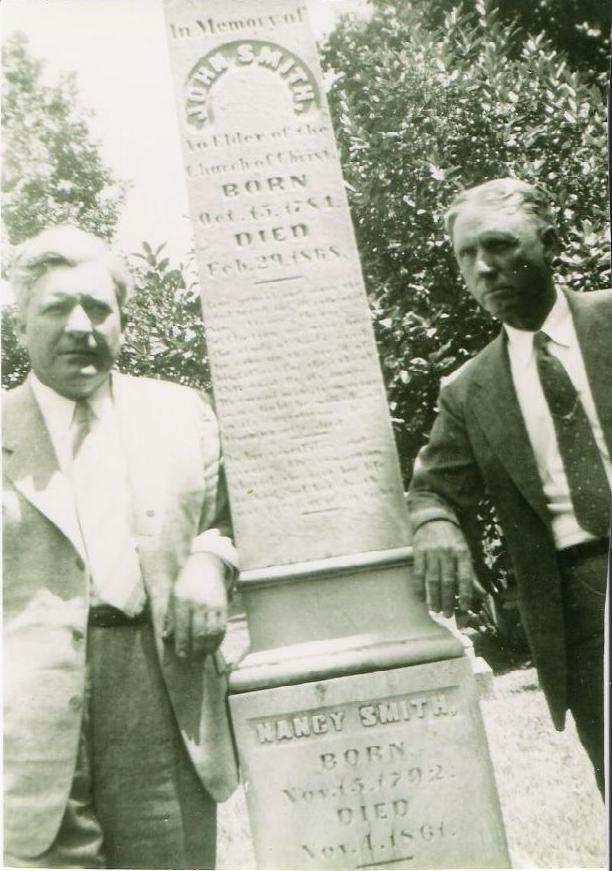
1941 Photo of Foy E. Wallace, Jr. And His Travelling Song Leader Austin Taylor At The Smith Grave
Contributed by Terry J. Gardner - 3.2010
![]()
Directions To The Grave Of John Smith
Lexington Cemetery is one of the most beautiful old cemeteries in America. It is located on West Main Street heading away from downtown Lexington toward Leestown Pike. Turn right into the main entrance past the office. Once inside the gates take the second turn to the left that leads up to the front of the Clay Monument. Then turn left onto West Main Avenue. Follow the road on around past Section "D & H" Then you will come to Section "O" Smith is buried in Section "O" just across from the corner of section "I" where John T. Johnson is buried.
Note: While at Smith's grave be sure to see the graves of Dr. Henry H. Halley, Lewis L. Pinkerton, John T. Johnson, I.B. Grubbs & Robert Milligan who are buried very near.
![]()
GPS Location
38°03'30.1"N 84°30'38.2"W
38.058369, -84.510600
Section O Lot 130
![]()
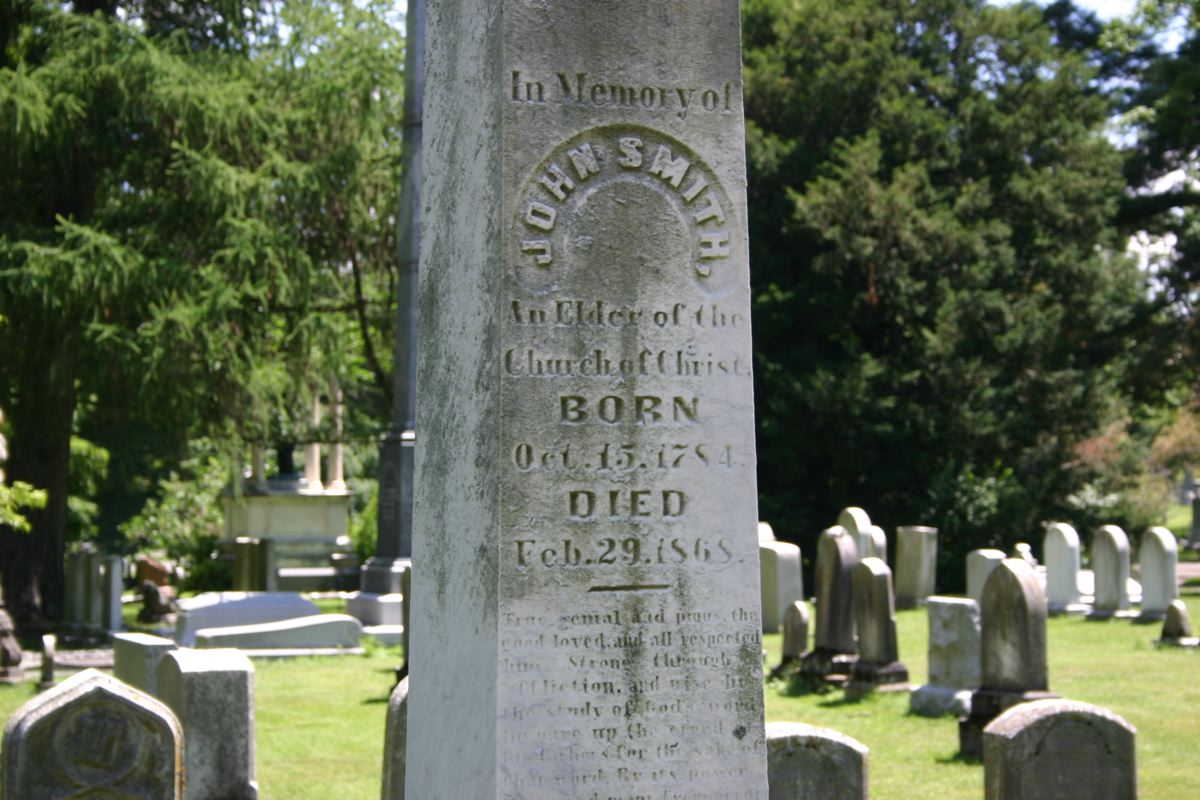
Monument As Seen In 2001
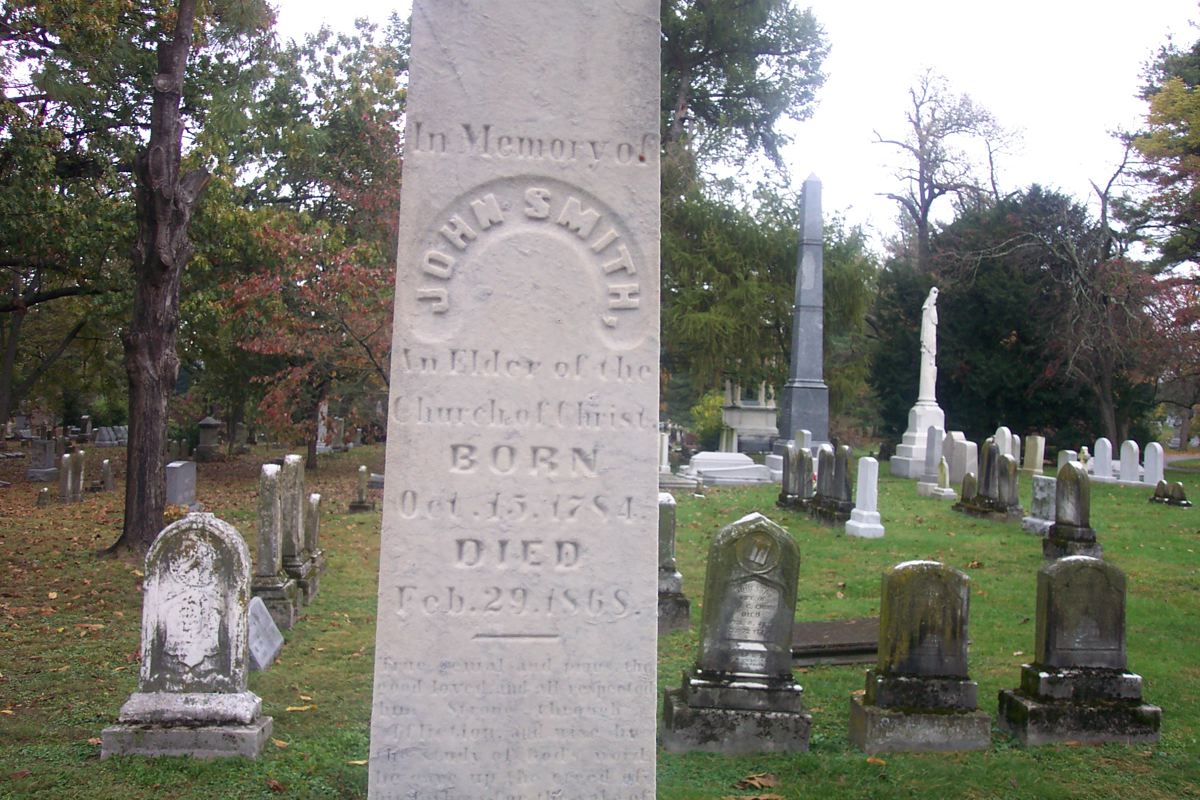
In Memory Of
JOHN SMITH
An Elder Of The
Church of Christ
Born
October 15, 1784
Died
February 29, 1868
True, genial and pious,
the good loved, and all respected
him. Strong through
affliction and wise
in the study of God's word.
He gave up the creed of
his fathers for the sake of
that word. By its power
he turned many from error.
In the light he walked
& in its consolation he
triumphantly died.
__________
In his sacrifices and
service. His companion
shared. She gave her life
to God & her death
was precious in his sight.
_________________
NANCY SMITH
Born
November 15, 1792
Died
November 4, 1861
![]()
See Where Smith Is Buried At Lexington Cemetery
Owingsville, Kentucky Home of John Smith
See Smith's Horse Hollow Cabin Here
See Remnants And Location Of The Old Lulbegrud Church
Smith's Influence on the daughter of Joseph P. Howe
![]()
